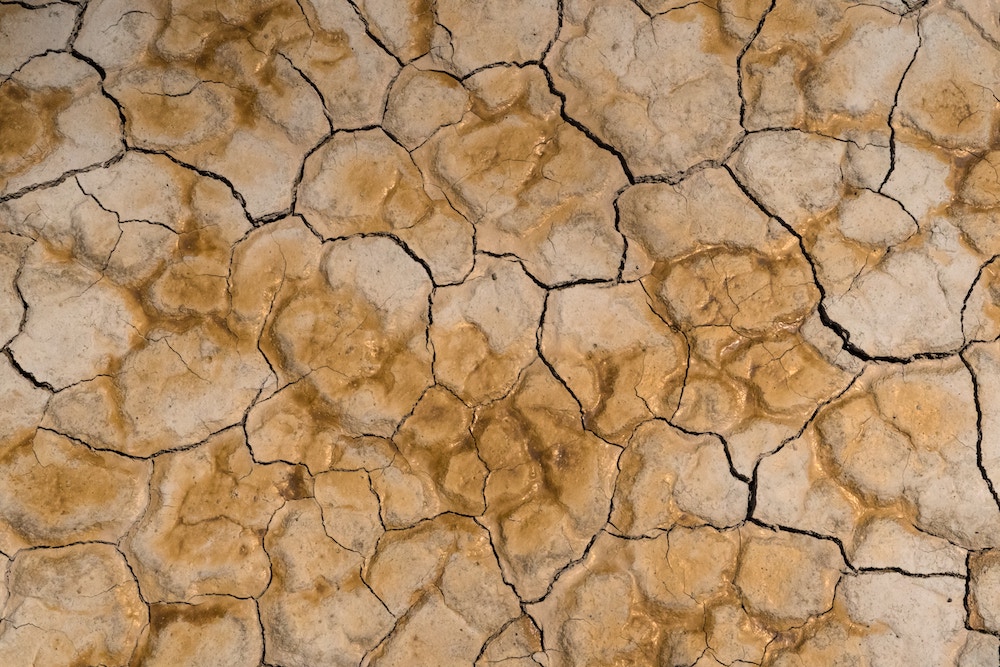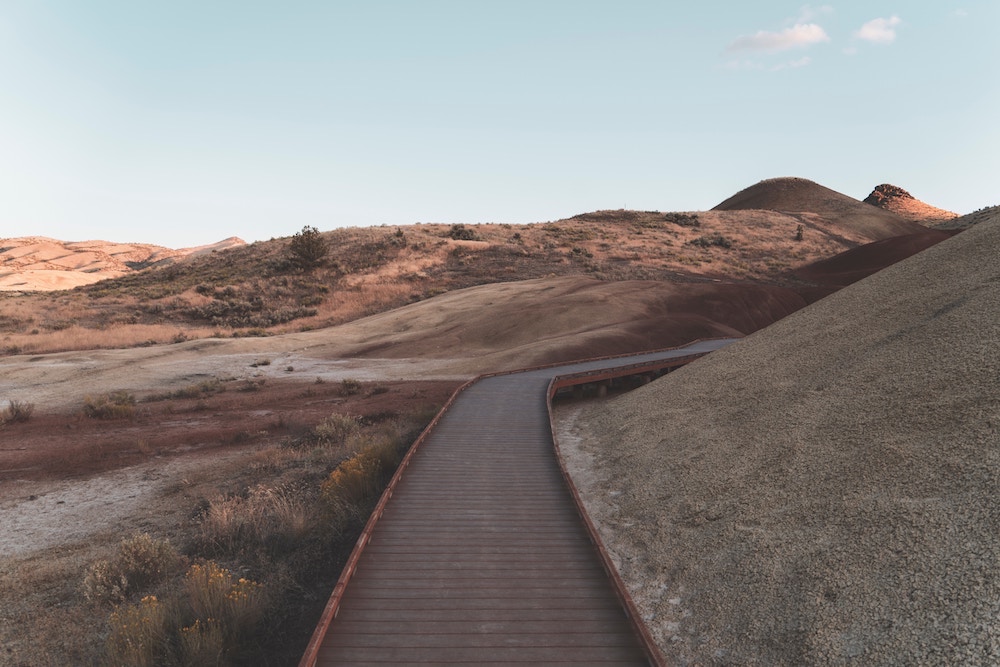Essay by Derick B. Donahoe
Chasing Water in Central Oregon

One of the things Mary and I like best about living in southwest Ohio is all the rain. We like to sit on our front porch and watch the water come down. Down from the sky. Because where we lived and farmed and raised our kids for much of our lives, it didn’t. Water came down the ditch.
The ditch, as we all called it, was the final leg of a miles-long system of streams, rivers, reservoirs, and canals. It brought water from the line of snow-capped peaks beyond the western fence line to our farmstead on the central Oregon high desert. We lived and worked there for almost thirty years, until we moved to the Midwest in 1996.
Almost the size of Vermont, central Oregon is located in a rain shadow east of the Cascades. It’s a rock-strewn land of dry canyons and buttes that starts at several thousand feet and goes up from there. The land is classified as desert; it gets less than ten inches of rainfall a year.
As with most of the rural population, irrigation water was the lifeblood we relied on for everything: raising crops; watering livestock; and filling the cistern that provided our household needs, including the water we drank. We liked to say our water was “well pasteurized” after having come down through everybody’s pasture.
Our one hundred acres entitled us to eighty acre-feet of water rights, with an acre-foot of water defined as enough to cover one acre, twelve inches deep. This we received over the course of a season that ran roughly mid-April to mid-October. Our remaining twenty acres of dry land consisted of the sagebrush and juniper that define Oregon east of the mountains, the eastern two-thirds of the state.
From a canal almost too wide to jump across that ran through our farm, we accessed water by means of head gates, mini-guillotine-like devices, one on each side of the ditch, that could be raised and lowered to let water through. It then passed over a weir, where it was measured to within a fraction of an inch—and not one drop more.
• • •
The entire system was owned and maintained by the Central Oregon Irrigation District (COID), a municipal corporation responsible for delivering the water a property owner paid for each year. If this sounds fairly straightforward, it wasn’t. The system was based on available water, which could vary from year to year, depending not only on the amount of snow that fell in the mountains (usually twenty to thirty feet) but when it fell. Late-fall and early-winter snows were most valuable for our snowpack. They compacted more densely, releasing water longer into the summer months than spring snows, which tended to melt and be lost to runoff.
Besides a crew to maintain canals and the system in general, the COID had a team of “ditch riders” to monitor water flows and keep an eye on things. The system covered a large area, and it relied to some extent on the honor system—so you can imagine how, in the middle of a long hot summer, a property owner might be tempted to crank their head gate up a notch.
It’s said that a man from the West will fight over three things—water, women, and gold—usually in that order. And did we ever! Not only with neighbors up and down the ditch, who we suspected of taking our water (and who suspected us of taking theirs), but with ditch riders and a company not always above playing favorites. By the time they shut the water off in the fall, I felt like I’d been run through the proverbial ringer and hung out to dry.
If it only ended there. About the time our battles slowed to a halt outside our house, the water battles resumed inside. Our cistern, which took up half the basement, held something over a thousand gallons, not much when you consider that the average American uses over a hundred gallons a day. During the winter, the ditch company ran water once a month for a day or two to fill stock ponds and cisterns. With our family of four, especially during the kids’ teenage years, too many interactions swirled around who was wasting water. “Turn off the shower now!” How relieved we all were come spring, when the water returned and we could get back to our outside water battles.
Every few years, we cleaned the cistern. This meant shoveling several inches of muck off the bottom, which invariably held skeletons of frogs, mice, and snakes.
One cold winter day in the mid-1980s, the phone rang, and it was Johnny Johnson. I’d never met Johnny, though in the way of rural communities, I knew who he was.
Rick, I’m looking at my map and see you don’t have a well.
You’re right, Johnny. Don’t have any money, either.
Not a problem. You’re not going anywhere, Rick, I’m not going anywhere, and I’ve got a drill rig just sittin’ here. I’m gonna come drill you a well, the wife will make up a book to keep track, and you can pay when you can.
Johnny’s call had come at just the right time. A few days earlier, I’d been working up at the main canal, dry at the time, when a cat walked out of the weeds and scratched a hole in the sandy bottom.

• • •
Our farm was in two parcels of fifty acres each. The fifty we lived on was flood-irrigated hay and pasture ground on which we kept horses and a small herd of cattle. Flood irrigating involved running water down one of the many small ditches bordering our fields and setting canvas dams to flood water out over the thirsty ground. Because dams needed to be moved several times a day and sometimes during the night, with kids in school and parents with day jobs, “chasing water” was a family affair.
Neither Mary nor I had been raised in irrigated country, and we didn’t realize the degree to which irrigation saturated our lives until our first trip to the Oregon coast, when our four-year-old son looked out over the Pacific and exclaimed, “What a big ditch!”
On our other fifty acres, we grew commercial peppermint under an old “hand-line” sprinkler system. A forerunner of the automated wheel-line and circle-pivot systems, it meant moving one hundred thirty-foot aluminum pipes by hand back and forth across a grid each morning and evening. Murphy’s Law—everything that can go wrong will go wrong and at the worst possible time—pretty well describes the endless succession of burned-up pumps, leaking valves, and plugged-up sprinklers, not to mention trudging over a mile in hip boots through waist-high wet peppermint day after day, year after year.
Those days, long gone now, are a far cry from our lives in southwestern Ohio, where it doesn’t freeze on the Fourth of July, where the soil is so deep and rich you plant seeds in the ground and jump back, where the rains come like clockwork—where, on a hot summer day, Mary and I like to sit on our front porch and watch the water come down. Down from the sky.

Publishing Information
- “Climate—Redmond, Oregon” (average rainfall), U.S. Climate Data.
- Central Oregon Irrigation District website.
Art Information
- “Droplets” © Santosh Kumar; Creative Commons license.
- “Alvord Desert Floor, Oregon” and “Wooden Pathway” © Dan Meyers; public domain.
 A farrier by trade, Rick, along with his wife Mary and two children, raised livestock and commercial peppermint on a farmstead in central Oregon’s high desert for many years.
A farrier by trade, Rick, along with his wife Mary and two children, raised livestock and commercial peppermint on a farmstead in central Oregon’s high desert for many years.
